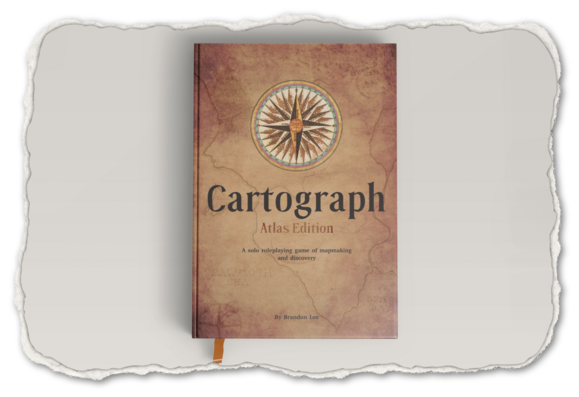We may earn money or products from the companies mentioned in this post.
As a general rule, I don’t really get journaling games. It seems like they just unnecessarily complicate perfectly good writing prompts. The only ones that really get a second look from me are the ones where you’re creating something other than a story, especially if that thing is something you can actually use in a game: a culture, a guild, a history, a spaceship, whatever. The ones where you play a game that generates a map tend to snag my money at a higher rate than others, so I backed Cartograph: Atlas Edition by Brandon Lee (not that one) when I saw it on Kickstarter.
The PDF was delivered yesterday. Normally such downloads go into the hellish limbo that is my “games I should play or read or at least look at eventually” folder, often never to be heard from again. Yesterday, however, I was off work and in just the right mood to start reading Cartograph as soon as I downloaded it. It was a quick read and looked fun, so I actually played through a game.
The Cartographer
You start the game by making up a “character” for your cartographer. While you’re allowed to pick and choose or make up your own descriptors, I decided that for the first play-thru I’d roll for everything (including my name) on the tables provided. Here’s the character I ended up with:
Name: Harlow Adkar
Pronouns: He/Him
Specialization: Nomad
Value: Experience
Disposition: Excitable
Background: The land I came from was dangerous yet beautiful. I decided to leave because I had a vivid dream that compelled me toward adventure. But I left behind a lifelong companion.
Characteristics:
Wide, pointed ears
Deep forehead wrinkles
Religious Adornments
Covered in satchels and pockets
Most of the descriptors are just used to inform your journal entries, but Specialization actually affects the game mechanics–I think mine gave me an extra Biome Dice.
In addition to the tags above, your character has a Reputation score that starts at 0, 3 types of resources (Coins, Wares, and Food) that you start with 1 each of, Items, and Wounds (you have no stuff and no injuries at the beginning of the game). You also have a pool consisting of 3 types of dice of different colors: Landmark Dice, Biome Dice, and Temporary Dice.
Game Play
The turn begins with the Exploration Phase. First off, you roll your dice pool on the sheet of paper where you’ll draw your map. Once the dice have landed, you start by drawing some coastline (“just a few centimeters” is the official measure–I went with about an inch) alongside each Landmark Die. Alternately, you can draw the coast all the way around the die, creating an island. Then you check the number for each landmark and biome dice. Temporary Dice can count as either die type, so if you’re counting any as Landmark Dice they also get a coastline. Next, you check the number of each die against a table and draw the corresponding feature on the map. Landmark Dice generate settlements and discoveries (or nothing), Biome Dice generate lakes, forests, mountains, etc. If two Biome Dice come up “lake” or “mountain,” you can connect them to create a river or mountain range.
Next is the Arrival Phase. You skip a couple steps on the first turn, but in general this phase consists of choosing a location to travel to (you have to spend 1 Food if it’s not the closest location) and drawing a dotted line from your current location to the new location. Then you draw a card (from a standard deck with 2 jokers) and consult the journey table to find out how the trip went and use the prompt provided for a journal entry. Then you look up the same card on the table for the feature type you’re visiting (Town, Discovery, Lake, etc). and write another journal entry for that. Journal entries often give you resource, items, wounds, or reputation, but not always.
Finally is the Rest Phase where you can gain resources and dice, swap different types of resources or dice for one another, sell wares, or shop for items. You don’t write a journal entry for the rest phase, but I sometimes included things from this phase in either the last or next entry.
Once you’ve rested, you go back to the Exploration Phase and start again. You keep going until you have a complete coastline (one edge of the page to the other) and 10 named location (you only name locations you visit) or an island with 5 named locations. The game can also end if you run out of food, take too many wounds, run out of dice, or draw 3 jokers of the same color. Jokers cause bad things to happen, and unlike the other cards you pull during the game, they get shuffled back into the deck.
The map I ended up with is posted below. The journal is going to be a Patreon exclusive. I should note that I forgot that I only needed 5 locations for an island and kept going a few turns longer than I had to. Also, while the Cartograph rulebook has tables for randomly generating names for a lot of things, I mostly used the Fantasy Name Generator page.

Criticisms
I ran into a few questions and issues while playing the game, but they were mostly minor.
- The first one is something there’s no easy way for the designer to address: Things kept popping up behind me when I rolled the dice on the map. For example, I didn’t get to explore any of the Discovery locations (the question marks on the map) because of all of them got added after I’d moved to another area. Again, it’s a fluke of rolling the dice on the page, but it does lead to weird cases where your cartographer blissfully passes by whole cities without noticing them (or at least without feeling a need to comment on them.
- Along similar lines, there came a point when the landmark dice were landing in the middle of a solid landmass, so drawing coastlines no longer made sense. I just stopped drawing them at that point, but I cold have drawn coastlines to make inland seas. The rules don’t really address which is the preferred method.
- Lee acknowledges in the rules that sometimes you’ll probably want to nudge the dice a little to make a better map, but is pretty vague about it. There were a few times (especially toward the end when I almost had a complete coastline) when I wasn’t sure if the amount of movement I did was really legit. It would be nice to have at least some kind of soft limit (“no more than an inch or so” or whatever) about how much you’re allowed to move the dice around.
- The “pay 1 Food if your destination is not the closest” caused a little confusion. First off, do locations I’ve already been count? It doesn’t really seem to me like they should, but in the rules as written they do. Also there are a few types of locations (see below) that don’t have prompt tables. Do those count when determining what’s closest?
- Ruins don’t have a prompt table, so it’s not entirely clear what you’re supposed to do if you visit one. The rules say that ruins count as wilderness, but there’s nothing about using a particular wilderness prompt table (the closest biome type, open ground, or whatever) to explore the ruins. One of my prompts told me to mark a Ruin near the city I’d just arrived in (I think the more common situation is that the city itself becomes a ruin), but the rules didn’t really give me a way to explore said ruin.
- I likewise wasn’t sure what to do when I came to a river. Do I treat it as a destination and pull a card for the Lake table? Do I have to spend resources to cross it? Do I just ignore it?
- On a more macro level, having something like 4 of the entries for the landmark dice be settlements leads to way too many towns. If I’m counting right, my little island had 6 cities, 13 towns, and 3 encampments.
- I get the feeling that running out of dice should be one of the more common ways to lose the game, but I never really felt like it was a danger. I’m not sure whether that’s a design issue or just a fluke because I had so many towns on my map that I could always get more dice (I literally visited 1 lake, 1 forest, and 1 open land area–the rest were all towns).
- While I didn’t notice an issue, just having one (Ace through King) Journey Table could lead to some repetitive games, since you could end up with each result up to 4 times. Most of the other prompts have separate tables for Red and Black cards and I think it would have been a good idea here. In fact, since you use the Journey table so often, I might have even done four tables, one for each suit.
Overall
I enjoyed the game of cartograph I played. It took a few hours to complete the map, so clearly there was enough there to keep my attention. There are a few design issues, but some are unavoidable artifacts of the “roll the dice on paper” mechanic and most of the others are fairly minor. The PDF itself looks great, is well organized, and didn’t have any errors that I noticed. The game also comes with a character sheet, blank map sheet, a quick reference that was very handy during play, and some other useful bits and pieces. If you think you might like this game based on what I’ve said here, you can buy it at itch.io.





